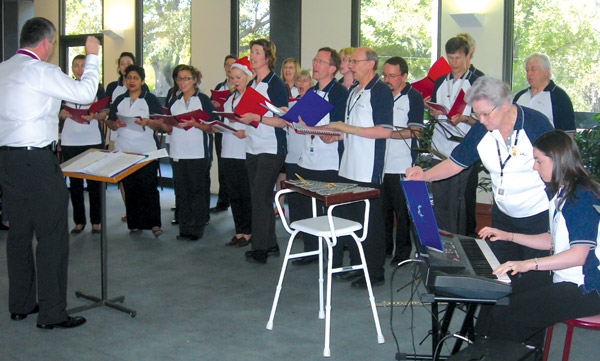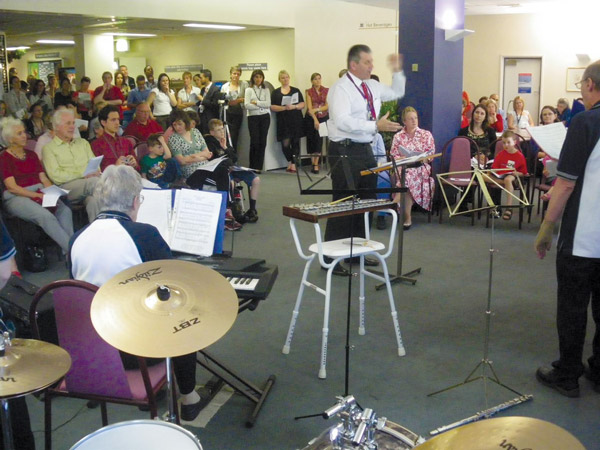For thousands of years, music has significantly enhanced health, character and behaviour.1,2 Music was prescribed to treat disorders in ancient Egypt and Greece, and throughout the Middle Ages, Renaissance and Baroque periods.1 Shamanic cultures still use music as part of rituals for maintaining health and supporting the dying and bereaved.2,3
Supported by Florence Nightingale, concerts were performed in London hospitals from 1891 and, by 1925, 15 New York hospitals had adopted the practice.4 After World War I, music therapy — a profession that tailors music techniques to individualised needs — emerged.5
In the present day, and closer to home, Melbourne Symphony Orchestra members have performed at the Royal Children’s Hospital,6 and tertiary music students regularly perform at St Vincent’s Hospital, Melbourne. Choirs in Melbourne and other parts of Australia often perform in hospitals at Christmas.
The Peter MacCallum Cancer Centre (“Peter Mac”) in Melbourne is a public hospital with 94 inpatient beds, outpatient clinics and an outpatient radiotherapy service. Its Staff Christmas Choir has performed annually since 1956. Given the increasing emphasis on addressing supportive care needs in oncology,7,8 we decided to conduct a small research study on the effects of the staff choir on inpatients, outpatients and visitors during the Christmas period in 2008.
All hospital employees and volunteers are eligible to join the choir. Weekly rehearsals commence around October. Just before Christmas, the choir performs in four inpatient wards, two outpatient waiting areas, and the staff cafeteria (Box 1, Box 2).
As many people as possible who heard the performances were invited to fill out a questionnaire. We used both purposive sampling (approaching people as they departed mid-performance) and convenience sampling (approaching those who remained after performances).9 Questionnaires and pens were given out or located in waiting areas.
We used a constructivist (qualitative) research approach (wherein the knowledge gained from interviews with participants is compared and systematically condensed by the researcher), reflecting our belief that people’s interpretations of the world differ according to their backgrounds.10 The design, informed by grounded theory (an inductive approach in which theory is developed from the data, rather than proposing hypotheses and gathering data to test them), was selected because it allows phenomena to be explained through analysing participants’ and researchers’ interpretations.9,11
Patient and visitor responses were transcribed and subjected to comparative thematic analysis,9,11 with software support.12 Initial analysis (by C C O) encompassed three iterative phases: descriptive labels were created to represent text segments, comparable codes were grouped into categories, and comparable categories were grouped into themes.
Qualitative inter-rater reliability13 was assessed: two authors (C J H and E J P) analysed the data and C C O’s original interpretations. Further alterations were made until all researchers agreed with the interpretation of the findings.
Respondents’ demographic features are summarised in Box 3. Nearly all patients and visitors (104/111 [94%]) expressed positive responses. Observed reactions were mostly favourable, occasionally negligible, and rarely negative. Two people (one visitor and one outpatient) commented about the music’s loudness. Many observers moved towards the choir, while others ignored it. Some sang along, played instruments and joked with the conductor. A few cried with heads bowed.
Several emergent themes were identified.
Being a Jew I was singing Christmas carols . . . I am very proud . . . we Jews give the world Christianity. (Patient)
Brings us all together from all walks of life . . . when many are facing adversity. (Patient)
. . . even in the midst of gloom. Just enjoyed the moment, which is all we have. (Visitor)
The choir’s positive effects on respondents’ emotions, memories and images were comparable with music therapy’s effects in oncology.14 However, adverse experiences of oncology patients to music therapy have not been reported, possibly because music therapists work in therapeutic relationships with willing participants.15 Music alters mood through an extensive network of activated neural regions and connections involving pleasure, arousal, opioid transmission and dopamine production.16 Memory traces of previously heard music and experienced emotions are also involved.16 Witnessing the choir’s “happy” and “warm” performances (words quoted from respondents) may have also triggered mirror neurones.17
Respondents’ sad memories were accompanied by positive feelings. Through offering multiple messages in non-referential ways, music can expand listeners’ ways of thinking and feeling.18 Music’s power is reflected in its capacity to arouse paradoxical states, acknowledging our fears and grief alongside our thanksgiving and hope.19
In summary, the Christmas choir music was welcomed by many at Peter Mac and should be encouraged for supporting oncology patients and their visitors in similar facilities. In the words of a January 2009 article in The Age, “Music binds strangers simply because it does not speak to one person. It is the universal become personal”.20
- Clare C O’Callaghan1
- Colin J Hornby2
- Elizabeth J Pearson3
- David L Ball4
- Peter MacCallum Cancer Centre, Melbourne, VIC.
Clare O’Callaghan was supported by a National Health and Medical Research Council postdoctoral fellowship in palliative care. Philips Medical Systems provided pens. Our research was otherwise unfunded. We pay tribute to Jean Milne, Radiation Therapist at Peter Mac, who founded and then conducted the Peter Mac Staff Christmas Choir from 1955 to 1979. Colin Hornby has been the conductor from 1980 to the present.
None identified.
- 1. Rebollo Pratt R. A brief history of music and medicine. In: Lee MH, editor. Rehabilitation, music and human well-being. St Louis, Mo: MMB Music, 1989: 1-12.
- 2. Laderman C, Roseman M, editors. The performance of healing. New York: Routledge, 1996.
- 3. Ellis CJ. Aboriginal music: education for living. Brisbane: University of Queensland Press, 1985.
- 4. Edwards J. Antecedents of contemporary uses for music in healthcare contexts: the 1890s to the 1940s. In: Edwards J, editor. Music: promoting health and creating community in healthcare contexts. Newcastle, UK: Cambridge Scholars Publishing, 2007: 180-202.
- 5. Davis WB, Gfeller KE, Thaut MH. An introduction to music therapy theory and practice. 2nd ed. Boston: McGraw-Hill, 1999.
- 6. Shoemark H. Sweet melodies: combining the talents and knowledge of music therapy and elite musicianship. Voices 2009; 9 (2). http://www.voices.no/mainissues/mi40009000305.php (accessed Mar 2009).
- 7. Fitch M. Supportive care for cancer patients. Hosp Q 2000; 3 (4): 39-46.
- 8. Victorian Department of Human Services. Supportive care needs of people with cancer and their families. http://www.health.vic.gov.au/cancer/docs/suppcare/cosa06suppcare.pdf (accessed May 2009).
- 9. Lingard L, Albert M, Levinson W. Grounded theory, mixed methods and action research. BMJ 2008; 337: a567. doi: 10.1136/bmj.39602.690162.47.
- 10. Kuper A, Reeves S, Levinson W. Qualitative research: an introduction to reading and appraising qualitative research. BMJ 2008; 337: a288. doi: 10.1136/bmj.a288.
- 11. Corbin J, Strauss A. Basics of qualitative research 3e: techniques and procedures for developing grounded theory. Thousand Oaks, Calif: Sage Publications, 2008.
- 12. Muhr T. ATLAS.ti: the knowledge workbench [CD-ROM]. Version 5.0. Berlin: ATLAS.ti Scientific Software Development, 2005.
- 13. Kitto SC, Chesters J, Grbich C. Quality in qualitative research. Criteria for authors in the submission and assessment of qualitative research articles for the Medical Journal of Australia. Med J Aust 2008; 188: 243-246. <MJA full text>
- 14. O’Callaghan C, McDermott F. Music therapy’s relevance in a cancer hospital researched through a constructivist lens. J Music Ther 2004; 41: 151-185.
- 15. Bruscia KE. Defining music therapy. 2nd ed. Gilsum, NH: Barcelona Publishers, 1998.
- 16. Levitin D. This is your brain on music. London: Atlantic Books, 2006.
- 17. Keysers C, Gazzola V. Toward a unifying theory of social cognition. Prog Brain Res 2006; 156: 379-401.
- 18. Feld S. Communication, music and speech about music. In: Keil C, Feld S, editors. Music grooves. Chicago: University of Chicago Press, 1994: 77-94.
- 19. Frohnmayer J. Music and spirituality: defining the human condition. Int J Arts Med 1994; 3: 26-29.
- 20. McFadyen W. The universal made personal through the power of song. The Age (Melbourne) 2009; 31 Jan. http://www.theage.com .au/opinion/the-universal-made-personal-through-the-power-of-song-20090130-7u0p.html (accessed Sep 2009).







Abstract
Objective: To examine how performances by the Staff Christmas Choir of the Peter MacCallum Cancer Centre (“Peter Mac”) affected inpatients, outpatients and visitors in 2008.
Design, setting and participants: During the Christmas season 2008, the Peter Mac Staff Christmas Choir gave seven performances at the Centre. Locations included inpatient wards, outpatient waiting areas and a cafeteria. To assess their response to the choir, oncology inpatients, outpatients and visitors (including early-departing bystanders) were given anonymous, semi-structured questionnaires during and after performances. To analyse the responses, we used a constructivist research approach informed by grounded theory.
Main outcome measures: Participants’ descriptions of the choir’s effects on them.
Results: Questionnaires were returned by 111 people. The performances were received favourably by 93.7% of respondents, including nine from Jewish, Hindu or atheist backgrounds. Many said the music aroused positive emotions and memories. Several described transformative thoughts and physical reactions, felt affirmed by the Christmas spirit or message, and/or appreciated the peaceful or enlivened and social atmosphere. The choir also elicited personal perspectives about Christmas and Judaism, and the importance of “enjoying the moment”. Only three respondents (2.7%) reported adverse effects, relating to emotional and audible intrusiveness.
Conclusions: The Staff Christmas Choir created a supportive and uplifting atmosphere for many oncology patients and their visitors. However, responses from people from non-Christian backgrounds were limited, and further investigation is warranted to extend our understanding of the effect of Christmas music in Australian public health settings.